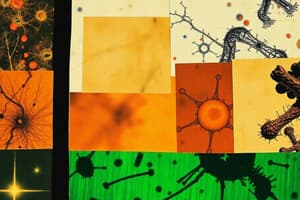Podcast
Questions and Answers
Prokaryotic cells lack a ______ membrane-bound nucleus
Prokaryotic cells lack a ______ membrane-bound nucleus
true
Eukaryotic cells have a ______ membrane-bound nucleus
Eukaryotic cells have a ______ membrane-bound nucleus
true
Mitochondria are the powerhouse of ______ cells
Mitochondria are the powerhouse of ______ cells
eukaryotic
Chloroplasts are found in ______ cells
Chloroplasts are found in ______ cells
Vaccines stimulate the immune system to protect against infections by specific ______
Vaccines stimulate the immune system to protect against infections by specific ______
Microbes can be beneficial, such as ______, or harmful, like pathogens
Microbes can be beneficial, such as ______, or harmful, like pathogens
Prokaryotic cells are characterized by their lack of a ______ and other membrane-bound organelles.
Prokaryotic cells are characterized by their lack of a ______ and other membrane-bound organelles.
Eukaryotic cells have a ______ and other membrane-bound organelles enclosed by a cell membrane.
Eukaryotic cells have a ______ and other membrane-bound organelles enclosed by a cell membrane.
Plant cells have a ______ which provides structural support and protection.
Plant cells have a ______ which provides structural support and protection.
Animal cells do not have ______ but have specialized organelles like lysosomes and peroxisomes.
Animal cells do not have ______ but have specialized organelles like lysosomes and peroxisomes.
Microbes are microorganisms like bacteria, viruses, and fungi, typically much smaller than ______ or plants.
Microbes are microorganisms like bacteria, viruses, and fungi, typically much smaller than ______ or plants.
Plant cells have ______ responsible for photosynthesis.
Plant cells have ______ responsible for photosynthesis.
Flashcards are hidden until you start studying
Study Notes
Prokaryotic vs Eukaryotic Cells, Animal vs Plant Cells, Microbes vs Vaccines, Characteristics of Living Things
Prokaryotic vs Eukaryotic Cells
Prokaryotic cells are the simplest form of cells, characterized by their lack of a nucleus and other membrane-bound organelles. These cells are primarily composed of bacteria and archaea, which are single-celled organisms. They have a smaller genome size and a simpler structure compared to eukaryotic cells.
Eukaryotic cells, on the other hand, have a nucleus and other membrane-bound organelles that are enclosed by a cell membrane. Eukaryotic cells are more complex and larger than prokaryotic cells. They are found in multicellular organisms, such as fungi, plants, and animals.
Animal vs Plant Cells
Animal cells and plant cells share some similarities, but they also have distinct differences. Both types of cells have membrane-bound organelles, such as the nucleus and mitochondria. However, plant cells have a cell wall, which provides structural support and protection, while animal cells do not have a cell wall.
Plant cells also have chloroplasts, which are responsible for photosynthesis. Animal cells do not have chloroplasts, but they have other specialized organelles, such as lysosomes for waste disposal and peroxisomes for metabolic processes.
Microbes vs Vaccines
Microbes are microorganisms, such as bacteria, viruses, and fungi, that are typically much smaller than animals or plants. They can be beneficial, such as probiotics, or harmful, like pathogens that cause diseases.
Vaccines are substances that stimulate the immune system to protect against infections by specific pathogens. Vaccines can be produced using microbes, such as live attenuated vaccines that are weakened versions of the pathogen, or using non-microbial components, such as subunit vaccines that contain specific proteins from the pathogen.
Characteristics of Living Things
Living things, whether they are prokaryotic or eukaryotic, share certain characteristics that distinguish them from non-living things. They are composed of cells, which are the basic units of life. They have the ability to grow, reproduce, maintain homeostasis, and respond to their environment.
Living things also have a metabolism, which is the set of chemical reactions that occur within cells to maintain life. They need to obtain energy and nutrients from their environment and convert them into the energy and materials they need to survive.
In conclusion, understanding the differences and similarities between prokaryotic and eukaryotic cells, animal and plant cells, and microbes and vaccines, as well as the characteristics of living things, is crucial for advancing our knowledge in biology and developing new technologies to improve human and animal health.
Studying That Suits You
Use AI to generate personalized quizzes and flashcards to suit your learning preferences.




